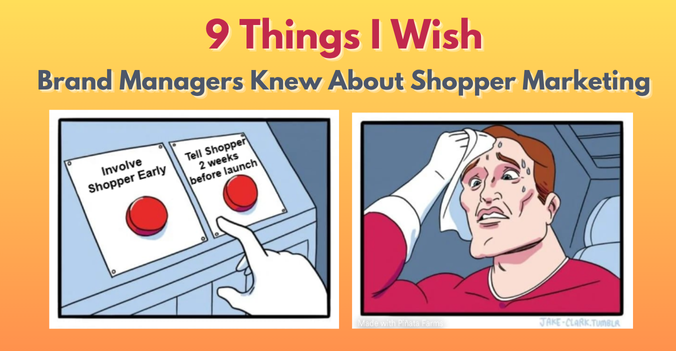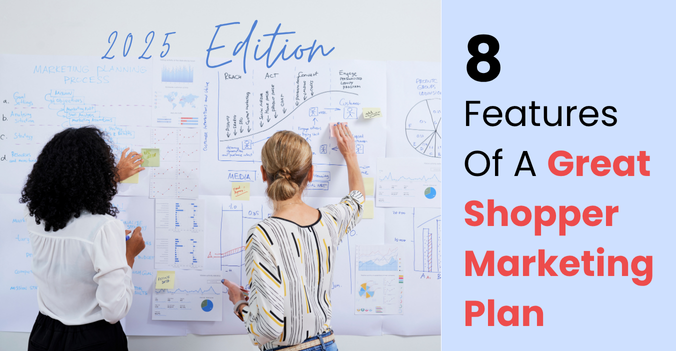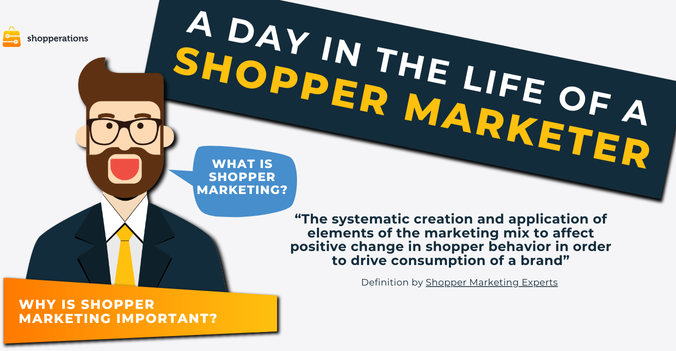
I wrote a similar post a few years ago. Boy, has the world changed since then or what? The discipline of CPG marketing has become even more technical, complex, and dynamic. Expectations for omnichannel shopper marketing plans have cranked up, too. To prepare your team for success in today’s omnichannel retail environment—where media is fragmented, ownership lines are blurred, and digital and in-store moments must connect seamlessly—your marketing planning process needs a reboot. That reboot must include retail media as a core channel, not just an add-on.
So, what does it take to build a great shopper marketing plan in 2025? These eight features remain essential for CPGs that want to stay relevant, accountable, and agile in a fast-changing retail world.
1. Integrated & Strategically Aligned
A shopper marketing plan should never exist in a vacuum. It must build on your brand’s overarching strategy and align with key retailer priorities. Great plans weave together brand campaigns, customer insights, retail media investments, and trade activation into a unified message that delivers at the shelf and beyond.
If your brand is negotiating a celebrity endorsement, make sure the retail media team is looped in early to secure exclusive content and appearances. If a key retailer announces a meal occasion push, your brand team should consider tailoring digital content to support that strategy.
Cross-functional collaboration isn’t just nice to have—it’s foundational.
2. Customer-Specific
Even if your media is bought nationally, your plan should roll up from the retail customer level. Why? Because:
-
It lets you create retailer-specific calendars and decks for your sales team.
-
It helps avoid legal headaches around Robinson-Patman compliance.
-
It enables accurate ROI analysis by customer.
Think of this as the CPG version of "personalization at scale."
3. Timely (and Often Early)
While digital media can be executed in days, many core shopper tactics—demos, displays, in-store merchandising—require 6 to 12 months of lead time. That’s why shopper marketing often precedes brand marketing in the annual planning cycle.
Embrace the fact that you’re upstream, not downstream. Your early plans often inform JBP discussions, agency briefs, and even media mix modeling. That’s not a burden—it’s influence.
4. Financially Aligned
Finance doesn’t think in campaigns. They think in ledgers, cost centers, and phasing. If you want to avoid re-packaging your plans for finance every quarter, make your plan finance-ready from the start.
Capture:
-
GL mapping by tactic type
-
Above-the-line vs. below-the-line spend classification
-
Funding sources (brand, customer, shopper)
-
Accurate in-market dates for clean phasing
When your plan speaks Finance’s language, your team earns trust—and avoids endless reconciliation fire drills.
5. Agile & Real-Time
Let’s be honest: the idea of a “planning season” is obsolete. Your plan is a living, breathing document that changes constantly—because your customers change constantly.
If your planning tool requires versioning six Excel tabs and reformatting for every update, it’s a bottleneck, not a solution. Use cloud-based software that enables quick edits, team collaboration, and real-time visibility.
If your plan isn’t easy to pivot, it’s not a plan—it’s a PowerPoint with commitment issues.
6. Measurable
Everyone wants better ROI. But shopper measurement is only useful if it’s:
-
Planned upfront
-
Focused on a few key KPIs
-
Acted on
Avoid vanity metrics. Instead, define a measurement plan before activation. Document what “good” looks like. And most importantly—adjust future plans based on what you learn.
Measurement isn’t a retrospective task. It’s a planning requirement.
Retail media measurement, in particular, needs to move beyond impressions and CTRs. Tie investments to incrementality, sales lift, or at the very least, actionable shopper behaviors.
7. Transparent & Accessible
Shopper marketing plans shouldn’t be locked in local folders or scattered across decks. They should be visible, accessible, and self-serve.
Store your plan in a collaborative tool that lets cross-functional partners view, filter, and pull reports without pinging your team 15 times a week. Transparency builds credibility and eliminates the perception that shopper dollars disappear into a black hole.
If your team is doing great work, let the plan show it.
8. Experimental (with Guardrails)
Shopper marketing is often the front line for retailer innovation. That’s why your plan needs built-in room to test and learn.
Create a sandbox budget. Define criteria for pilots. Share learnings widely. The goal is to decentralize decision-making, say "yes" quickly when retailers come knocking with beta programs—but with structure that ensures accountability and knowledge-sharing.
Decentralization + guardrails = speed and smarter innovation.
Bonus: AI-Driven Scenario Planning
This one’s new—and it’s changing the game.
In 2025, leading teams are exploring AI tools that:
-
Suggest tactics based on prior performance
-
Automatically forecast spend and phasing
-
Draft recaps and reports
-
Detect gaps or overlaps across tactics
-
Generate retailer-specific calendars in seconds
While still emerging, these tools unlock strategic capacity by automating the grunt work of planning and reporting. Think of it as a co-pilot—not a replacement—for smart marketers.
How many of these features does your shopper marketing plan check off?
Where are you ahead of the curve—and where might a tune-up help?
If you're looking to benchmark your company against CPG peers in terms of productivity, org design, process efficiency, or systems and data management, we can help. Hire us to conduct a benchmarking audit and kickstart your digital transformation journey.
OTHER POSTS YOU MIGHT LIKE:
How to Strategically Leverage RMN Investments
RETAIL ACCOUNT PENETRATION STRATEGIES FOR SHOPPER MARKETERS
7 PEOPLE EVERY SHOPPER MARKETING TEAM NEEDS









